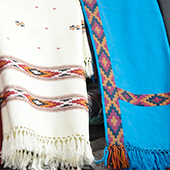Design Resource
Kullu Shawls - Himachal Pradesh
Handicraft
by
Handicrafts from Himachal have admirers from all around the world; among them, all “Kullu Shawls” hold the best position. Kullu is the capital town of the Kullu district in the Indian state of Himachal Pradesh. It is located on the banks of the Beas River in the Kullu Valley. The valley has many pilgrimage sites for Hindus, Buddhists, and Sikhs; hence, it is known as ‘Dev Bhumi’. Kullu valley is known for Kullu shawls made of many natural fibers, including pashmina, sheep wool, and Angora. The fine woolen fabric and manufacturing quality, bright colours with geometrical patterns make Kullu shawl famous all over the world.
Due to a lack of transportation facilities during the pre-independence era, industrialized products couldn’t reach the valley. Kullvi people inhabit the cold temperate Himalayan region which is suitable for sheep and goat rearing, which also fulfills the necessity for woolens. In the beginning, the people of Kullu used to weave ‘Patti’, which means a short width local tweed, protects against snow, rain, and wind. This fabric is woven with sheep wool to fulfill the bare necessity of covering their body and protecting themselves from severe cold. Formerly, Kullvi people were weaving plain shawls, but when weavers from Bushehar (Shimla) came to the valley in the early 1940s, their craft influenced the people of Kullu Valley. The weavers of Bushehar were familiar with the geometrical designs, which they successfully used on Pattus, and the trend of patterned shawls came to rise.
Traditionally, black, white, and brown or natural grey colours are used as the base, and bright colours like yellow, red, green, orange, blue, etc., were used for patterning in Kullu shawls. Nowadays, according to consumers’ demand, these traditional bright colours are being replaced by pastel colours. Each design may have one to eight colours. Sheep wool, Pashmina, Yak wool, Angora, and handspun material are used to make Kullu shawls. These yarns are vegetable dyed or chemically dyed. Plain shawl made of single colour without any design or pattern, plain with the border of a traditional pattern or coloured stripes on the four sides, with the traditional pattern on its both ends, with three traditional patterns on two ends, having all over design are few types of patterns used for weaving shawls. Kullu shawls are in great demand among tourists. Every tourist visiting Himachal Pradesh, especially Kullu, buys a shawl to remind their journey to this hilly state. Kullu shawl has benefited globally, but weavers need to be protected to save handloom sector handlooms.






